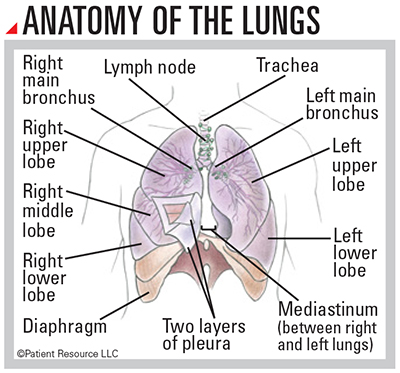Small Cell Lung Cancer
Introduction
Small cell lung cancer (SCLC) is an uncommon form of lung cancer. Although it has traditionally been very challenging to treat, it may be comforting to know that new drugs, treatment strategies and clinical trials are making great strides in how SCLC is treated and managed. The result is more options, and more hope, for people facing this aggressive lung cancer.

How Lungs Function
The lungs are a pair of large, spongy, expandable organs in your chest cavity that are surrounded by a thin layer of protective tissue (pleura). The right lung is a little larger with three parts (lobes), and the smaller left lung has two lobes (see Anatomy of the Lungs).
Your lungs expand and contract when you breathe, exchanging oxygen and carbon dioxide. When you inhale, your lungs fill with oxygen-rich air, which is delivered to red blood cells that then deliver the oxygen to the rest of your body. When you exhale, the carbon dioxide that is brought back to the lungs by red blood cells is expelled into the air. Your diaphragm, a dome-shaped muscle underneath your lungs, initiates this cycle of expansion and contraction.
Abnormal cells in the lining of the airways can accumulate to form a tissue mass (primary tumor). A primary tumor may grow into the lining around the lung and form secondary tumors nearby. In advanced disease, lung cancer cells break away to form tumors in the opposite lung and in distant sites such as the liver, brain or bones. These are known as metastases. Even though they are in other parts of the body, they are still considered lung cancer and are treated as such.
Types of Lung Cancer
Lung cancer is more complicated than many people realize. There are many types, and they fall into two main classifications: small cell lung cancer (SCLC) and non-small cell lung cancer (NSCLC). NSCLC makes up the majority of lung cancer diagnoses and has several subtypes. Other less common types of lung cancer, which can also begin in other organs, include mesothelioma, sarcoma, lymphoma and others. This guide focuses on SCLC.
SCLC often starts in the central airways (bronchi) in the center of the chest and frequently spreads to distant parts of the body before it is found. It is considered the most common type of neuroendocrine tumor of the lung (see Understanding neuroendocrine tumors below).
Cancer is a disease of our genes, which are pieces of DNA in our cells. DNA refers to the molecules inside cells that carry genetic information that is passed from one generation to the next. Cancer forms when genes begin to change, or mutate (change), within the structure of normal cells. Cancers are driven by a mixture of specific mutations, which can either be acquired during a person’s lifetime (from environmental factors such as smoking) or are hereditary (inherited from a parent). The mutations found in SCLC are not inherited.
A biopsy sample will be reviewed under a microscope by a pathologist. Molecular/genomic testing will be performed on the sample to confirm the diagnosis and look for any mutations, which may indicate the SCLC’s subtype and whether certain treatments may be more effective.
SCLC is named for its appearance under a microscope. It is aggressive and typically has multiple mutations in the tumor’s DNA. The most common are in the TP53 and RB1 tumor suppressor genes and as a deletion in the chromosome arm 3p. A normal tumor suppressor gene makes a protein that helps control cell growth. When that gene is mutated, it can no longer control cell growth, which may lead to cancer. A chromosome that has been changed (in this case, part of it is missing), may also lead to cancer.
In rare cases, SCLC cells can form from NSCLC cells that have molecular alterations.
Understanding neuroendocrine tumors
Neuroendocrine tumors (NETs) develop from cells that release hormones into the blood in response to a signal from the nervous system. They may make higher-than-normal amounts of hormones, which can cause many
different symptoms. NETs may begin in any part of the body, but they typically develop in the lungs, gastrointestinal tract and pancreas.
Neuroendocrine cells line the bronchi and other parts of the lung. These cells have multiple functions:
- Controlling air flow and blood flow in the lungs
- Controlling the growth of other types of lung cells
- Detecting levels of oxygen and carbon dioxide in the air we breathe, and releasing chemical messages to help the lungs adjust to these changes.
SCLC is the most common form of lung neuroendocrine tumor. It is aggressive and is likely to spread. The cells are poorly differentiated (they do not look like normal cells). SCLC can cause cancer in neuroendocrine cells and the submucosal lining of the airways.
Depending on the specific characteristics and health of the patient, a NET lung tumor may be treated differently than most SCLC diagnoses. Therapies may include surgery, chemotherapy, targeted therapy, radiation therapy, a combination of any of these or a clinical trial.



